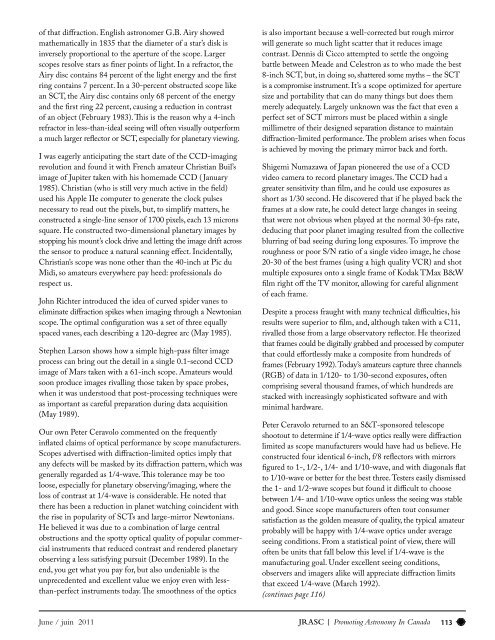The Running Man Nebula
The Running Man Nebula - The Royal Astronomical Society of ...
The Running Man Nebula - The Royal Astronomical Society of ...
Create successful ePaper yourself
Turn your PDF publications into a flip-book with our unique Google optimized e-Paper software.
of that diffraction. English astronomer G.B. Airy showedmathematically in 1835 that the diameter of a star’s disk isinversely proportional to the aperture of the scope. Largerscopes resolve stars as finer points of light. In a refractor, theAiry disc contains 84 percent of the light energy and the firstring contains 7 percent. In a 30-percent obstructed scope likean SCT, the Airy disc contains only 68 percent of the energyand the first ring 22 percent, causing a reduction in contrastof an object (February 1983). This is the reason why a 4-inchrefractor in less-than-ideal seeing will often visually outperforma much larger reflector or SCT, especially for planetary viewing.I was eagerly anticipating the start date of the CCD-imagingrevolution and found it with French amateur Christian Buil’simage of Jupiter taken with his homemade CCD ( January1985). Christian (who is still very much active in the field)used his Apple IIe computer to generate the clock pulsesnecessary to read out the pixels, but, to simplify matters, heconstructed a single-line sensor of 1700 pixels, each 13 micronssquare. He constructed two-dimensional planetary images bystopping his mount’s clock drive and letting the image drift acrossthe sensor to produce a natural scanning effect. Incidentally,Christian’s scope was none other than the 40-inch at Pic duMidi, so amateurs everywhere pay heed: professionals dorespect us.John Richter introduced the idea of curved spider vanes toeliminate diffraction spikes when imaging through a Newtonianscope. <strong>The</strong> optimal configuration was a set of three equallyspaced vanes, each describing a 120-degree arc (May 1985).Stephen Larson shows how a simple high-pass filter imageprocess can bring out the detail in a single 0.1-second CCDimage of Mars taken with a 61-inch scope. Amateurs wouldsoon produce images rivalling those taken by space probes,when it was understood that post-processing techniques wereas important as careful preparation during data acquisition(May 1989).Our own Peter Ceravolo commented on the frequentlyinflated claims of optical performance by scope manufacturers.Scopes advertised with diffraction-limited optics imply thatany defects will be masked by its diffraction pattern, which wasgenerally regarded as 1/4-wave. This tolerance may be tooloose, especially for planetary observing/imaging, where theloss of contrast at 1/4-wave is considerable. He noted thatthere has been a reduction in planet watching coincident withthe rise in popularity of SCTs and large-mirror Newtonians.He believed it was due to a combination of large centralobstructions and the spotty optical quality of popular commercialinstruments that reduced contrast and rendered planetaryobserving a less satisfying pursuit (December 1989). In theend, you get what you pay for, but also undeniable is theunprecedented and excellent value we enjoy even with lessthan-perfectinstruments today. <strong>The</strong> smoothness of the opticsis also important because a well-corrected but rough mirrorwill generate so much light scatter that it reduces imagecontrast. Dennis di Cicco attempted to settle the ongoingbattle between Meade and Celestron as to who made the best8-inch SCT, but, in doing so, shattered some myths – the SCTis a compromise instrument. It’s a scope optimized for aperturesize and portability that can do many things but does themmerely adequately. Largely unknown was the fact that even aperfect set of SCT mirrors must be placed within a singlemillimetre of their designed separation distance to maintaindiffraction-limited performance. <strong>The</strong> problem arises when focusis achieved by moving the primary mirror back and forth.Shigemi Numazawa of Japan pioneered the use of a CCDvideo camera to record planetary images. <strong>The</strong> CCD had agreater sensitivity than film, and he could use exposures asshort as 1/30 second. He discovered that if he played back theframes at a slow rate, he could detect large changes in seeingthat were not obvious when played at the normal 30-fps rate,deducing that poor planet imaging resulted from the collectiveblurring of bad seeing during long exposures. To improve theroughness or poor S/N ratio of a single video image, he chose20-30 of the best frames (using a high quality VCR) and shotmultiple exposures onto a single frame of Kodak TMax B&Wfilm right off the TV monitor, allowing for careful alignmentof each frame.Despite a process fraught with many technical difficulties, hisresults were superior to film, and, although taken with a C11,rivalled those from a large observatory reflector. He theorizedthat frames could be digitally grabbed and processed by computerthat could effortlessly make a composite from hundreds offrames (February 1992). Today’s amateurs capture three channels(RGB) of data in 1/120- to 1/30-second exposures, oftencomprising several thousand frames, of which hundreds arestacked with increasingly sophisticated software and withminimal hardware.Peter Ceravolo returned to an S&T-sponsored telescopeshootout to determine if 1/4-wave optics really were diffractionlimited as scope manufacturers would have had us believe. Heconstructed four identical 6-inch, f/8 reflectors with mirrorsfigured to 1-, 1/2-, 1/4- and 1/10-wave, and with diagonals flatto 1/10-wave or better for the best three. Testers easily dismissedthe 1- and 1/2-wave scopes but found it difficult to choosebetween 1/4- and 1/10-wave optics unless the seeing was stableand good. Since scope manufacturers often tout consumersatisfaction as the golden measure of quality, the typical amateurprobably will be happy with 1/4-wave optics under averageseeing conditions. From a statistical point of view, there willoften be units that fall below this level if 1/4-wave is themanufacturing goal. Under excellent seeing conditions,observers and imagers alike will appreciate diffraction limitsthat exceed 1/4-wave (March 1992).(continues page 116)June / juin 2011JRASC | Promoting Astronomy In Canada113
















